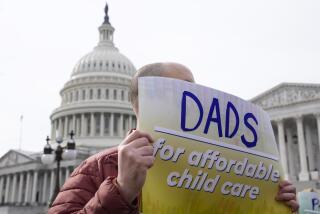Clinton Takes Some Risks With Tobacco Crackdown
- Share via
WASHINGTON — When President Clinton made history a year ago this month by calling for the Food and Drug Administration to regulate tobacco as an addictive drug, he injected a new term into the national lexicon.
He called cigarette smoking “a pediatric disease.”
It was a brilliant political stroke. By framing his controversial crackdown on tobacco as protection for children, the president delivered his opposition a slicing blow. Who, after all, could argue with saving the lives of kids?
Today, Clinton is expected to take his long-awaited plan off the drawing board and announce sweeping regulations designed to curb under-age smoking. But as tobacco foes celebrate and cigarette manufacturers gird for a pitched fight against the proposed new rules, a quiet debate is raging in public health circles about the wisdom of the president’s strategy.
Academics, tobacco-control authorities and even some government officials complain that casting smoking as a children’s issue ignores the significant health dangers that cigarettes and secondhand smoke pose for the entire population.
Moreover, they fear that portraying smoking as grown-ups-only behavior will make cigarettes seem more illicit, and therefore more attractive, to young people--achieving precisely the opposite effect that the FDA rules intend.
“The decision to frame the issue around kids was a very smart tactical move,” said Stanton Glantz, a UC San Francisco professor who has researched the links between cigarettes and heart disease. “But [it] has basically turned into a monster.”
Added Greg Connolly, chief of Massachusetts’ tobacco-control program: “You have to view smoking as a societal problem, not a kids’ problem. When you view it as a kids’ problem, you play into the tobacco industry’s game. . . . It sets smoking up as a risk-taking behavior, turning a rotten egg into a forbidden fruit.”
Administration officials, however, justify the emphasis on youth by saying that is where the biggest problem is. More than 90% of new smokers begin before the age of 18, and recent studies show that teenage smoking is on the rise again, reversing a 16-year decline.
“It’s a question of public health,” said FDA spokesman Jim O’Hara, “and the public health data clearly shows that if you can keep young people from beginning to smoke, they won’t become smokers [as adults.]”
“The proposed actions by the FDA are the best effort we can make to turn these trends around,” said Michael Eriksen, director of the Office on Smoking and Health at the U.S. Centers for Disease Control and Prevention. “It’s a well-thought-out strategy.”
But even Eriksen acknowledges that the emphasis on young people could backfire. “We have to be very cognizant of that risk,” he said.
At the same time, there is troubling evidence that hard-fought strides in the public health war against adult smoking are being eroded--and some critics say that the current talk about underage smoking is partly to blame.
In the last three decades, since the first U.S. surgeon general’s report on the dangers of cigarettes, smoking has declined dramatically among adults. Today, roughly one-quarter of Americans older than 18 are smokers, down from 42% in 1965.
But the steady decline is beginning to level off. In 1994, according to the CDC, 48 million Americans--25.5% of the adult population--were smokers, the same percentage as the previous year. In addition, per capita consumption of cigarettes--which began dropping off dramatically in the 1980s and reached a low of 485 billion in 1994--went up slightly last year.
There are various reasons for these shifts but experts said the focus on under-age smoking may also be a factor, as local tobacco-control advocates--always short of time and money--divert attention away from other tried-and-true strategies, such as pressing for clean indoor air laws and excise taxes on cigarettes.
Glantz, the San Francisco professor, said this is a mistake. He complained that the government is promoting the FDA rules as “a magic bullet, and it ain’t a magic bullet.”
Indeed, there is some question whether the FDA plan will achieve its goals. Donald Shopland, coordinator of the National Cancer Institute’s tobacco-control program, is skeptical, noting that efforts to reduce drug and alcohol use among young people have met largely with failure.
Under the proposal that Clinton put forth a year ago, the FDA would attempt to cut teen smoking in half over a seven-year period. If that goal was not met, the agency would revisit the issue and possibly suggest even more stringent restrictions.
Already, some scientists are looking ahead toward that time. Connolly, the Massachusetts official, paints a scenario in which the government would require manufacturers over a period of time to eliminate nicotine--generally accepted as the addictive component of tobacco--from cigarettes.
* SLOW BURN: Stricter tobacco laws cause concern in racing industry. C1
More to Read
Sign up for Essential California
The most important California stories and recommendations in your inbox every morning.
You may occasionally receive promotional content from the Los Angeles Times.













